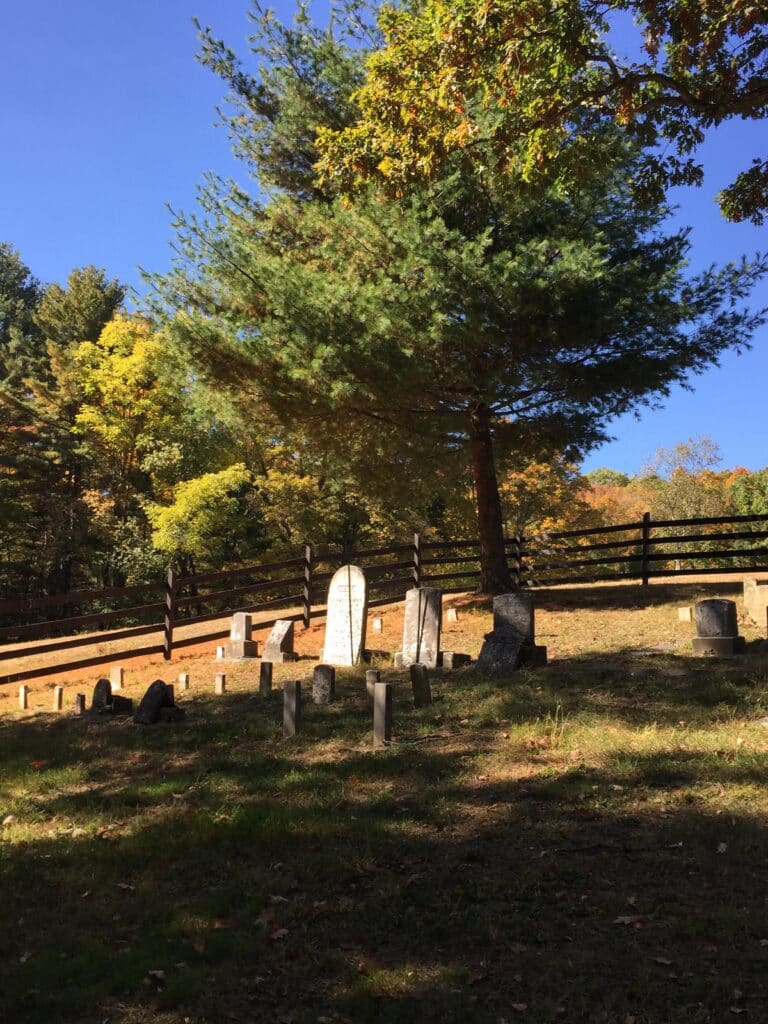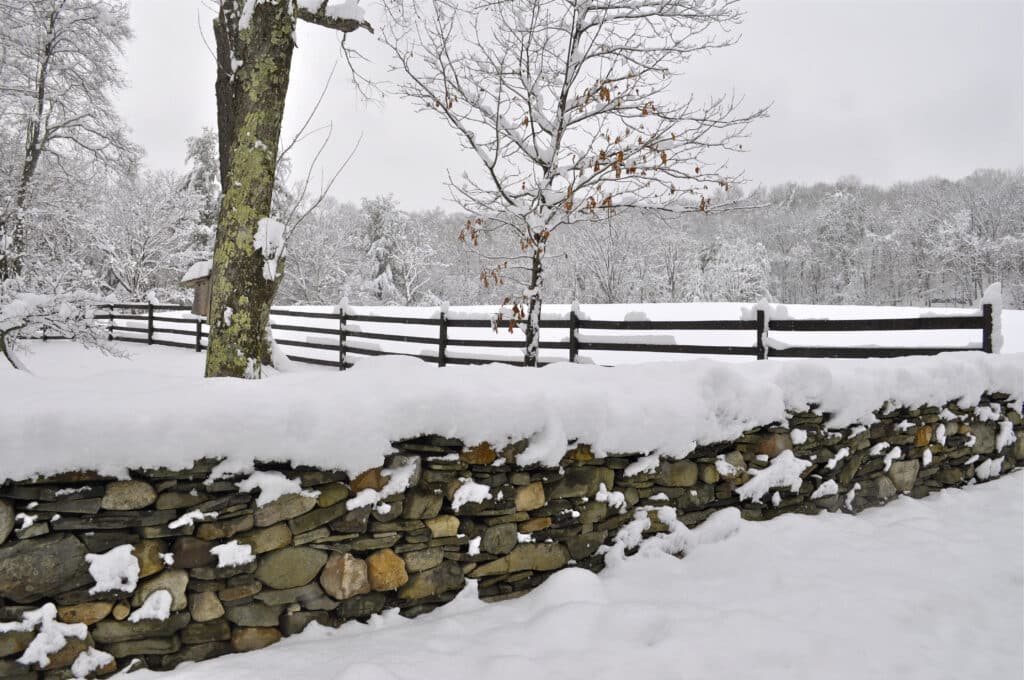Restoring the Small Graveyard
“When camp was being purchased,” Dale said, “there were two things we were told we wouldn’t own: Brandt Road, the road off of 209 that brings you to camp, and the cemetery. Both of these were owned by the township.”
The Camp Deerpark land was a farm in the 1800s that belonged to the Skinner family. You can still see evidence of their labor at camp in the stone fences they built for farm animals. Their barn eventually became a garage and workspace at camp.
There was also a family graveyard, which is located just down the road from what is now the chapel. Members of the Skinner clan are buried in the graveyard, along with extended family. Some type of illness must have struck the family as there were many deaths from the mid to late 1800s, including children.
“When we first came to camp, the cemetery was in disrepair,” said Doris. “Many of the gravestones had fallen over and were lying flat on the ground.”
Dale said, “There were two stone fences bordering the cemetery, but some stones had fallen down and it wasn’t in great shape. There was also an old wire fence on one side. Since we didn’t own the cemetery, over the years we didn’t do much to improve the space but around 2005, while I was visiting camp, I got the idea that we should fix it up. Over the years there had been a few inquiries about it—from distant relatives, I believe. I thought we should try and improve how it looked. Ken was in agreement that this was a good idea. I decided to go back to camp for a couple of days in August. Doris and I, Donna and her three children came along to help.”
“It looked like a big job,” said Doris. “The cemetery was full of brambles, and grown up with weeds. It was hard to know where to begin. ”Dale took a chainsaw to the brambles and, though it was a very hot day, progress was made. “We cleared out a lot of thick weeds and branches, and were able to see more of the gravestones,” said Dale. “Many of them were broken, but we tried to piece them together. It was a start.”
—Written by Donna Stoltzfus, former camper and staff.
Dale and Doris Stoltzfus, first director of camp, first head cook at camp, attended Glad Tidings Mennonite Church in the Bronx.
by Thomas Neufeld
When my grandfather asked me one summer to help do some cleanup work at Camp Deerpark, I agreed to go along, knowing how hard he had worked at camp over the years. I figured I could help out a bit. When we arrived—my grandparents, my mother and two sisters were along—I quickly realized that it was not going to be an easy job. We were going to clean up an old family cemetery that had fallen into disrepair. None of the gravestones were visible underneath all of the weeds and overgrowth. We worked for two days in blistering heat. It was August, humid, and around 98 degrees. My grandfather took a chainsaw and began to try to clear a path into the graveyard, where long patches of thorn bushes covered the graves. When we had cleared a sufficient amount of the weeds to uncover them, we found a disheartening sight; many of the stones were broken in multiple pieces and scattered. Jagged pieces stuck up from the ground and under large branches. So my grandfather and I decided to try to piece the gravestones back together and try to place them back in their original locations in the graveyard.
As we slowly gathered the pieces of gravestones, a family history emerged. It was a sobering moment when I came across four tiny markers, upside down and covered in dirt. After cleaning them, I read the years inscribed on them and realized that all four of them stood for young children, all of the same family, their births and deaths covering a period of barely over a decade. It was then I understood the full implications of what we were doing. We were not solely doing a form of yard work or tedious labor; we were restoring dignity to this family and its ancestors.

Julia M.
Died
July 10, 1864
Aged 2 years 2 months & 7 days
Patience T.
Died
July 23, 1864
Aged 10 months & 16 days
Children of
Festus and Ellen Skinner
How much we miss those infants dear
Twere vain to try to tell
To part with them seems too severe
But God does all things well.
A restoration research project was started after we left. More information is being found about the families buried there in town documents and archives. The graveyard today looks astonishing in comparison. I was glad to have the opportunity to help work in this small, but meaningful, family graveyard.
—Written by Thomas Neufeld, grandson of Dale and Doris Stoltzfus.
Excerpt from an essay written for a class assignment on volunteer work in 2005 at 14 years old.
with Kenton Baer
I went to camp for the first time in the fall of 2007. I had graduated from high school the previous spring and camp seemed like the perfect fit. Growing up and hearing all of dad’s stories about Camp Deerpark made it a pretty easy decision for me and I’m so happy that I chose to go. Camp and its community of people that come and go from week to week taught me more skills and life lessons then I could ever have imagined.
Ken or Sean asked me to work on the cemetery project. I think it was one of those projects that kind of evolved as it went. I believe I was asked to clear some of the underbrush away, but as soon as I started I quickly realized it was going to take more than that. So with a chainsaw and Kubota tractor rigged with an old rusty three point hitch backhoe I went to work cutting down trees and digging stumps. I believe I spent a solid two weeks just felling trees, digging stumps and clearing brush. As things slowly started to be cleared, one of the coolest things about the project for me was realizing that just within the boundaries of the graveyard there was somewhere around 15 different species of trees represented. I tried to leave at least one of each standing but sadly a few died soon after completing the project. (I suppose I had disturbed too much dirt around them.) After everything was cleared I, along with some help from Zachary Garber, rebuilt the stone wall along the road side. We then graded and planted grass.
I worked on the project on and off for a good chunk of the summer—maybe put in a solid month or more of work in total. It was lots of manual labor. It would take a fraction of the time today with all of the equipment that is on site now.
It always feels good to complete a project and that one was extra special, just because of how forgotten the area had become and how much people appreciated seeing the old family graveyard kept up once again.
—Written by Donna Stoltzfus, former camper and staff.
Kenton Baer, volunteer 2007–08, Promise Woods construction supervisor 2012–2015.
Related Entries
Share:
“How Do I Donate?”
Recently, a thirteen-year-old guest at Camp asked Operations Director Kevin Smith, “how do I donate?” Kevin was honestly a little surprised, but was happy to see this young member – who was on retreat with one of our owning churches — taking some initiative. Kevin directed him to the website Donate page, and the young…
The Discipleship Down-Low
Defining Discipleship 18 And Jesus came and said to them, “All authority in heaven and on earth has been given to me. 19 Go therefore and make disciples of all nations, baptizing them in the name of the Father and of the Son and of the Holy Spirit, 20 teaching them to observe all that I have commanded…
The Virtuous Wife
This past weekend, Camp hosted three women’s retreats at Camp. Though the retreat groups were very diverse in background – one was from an urban church plant in Philadelphia, one was from a Garifuna Mennonite church in Brooklyn (an Afro-Caribbean Culture), and one was from a multi-ethnic faith community reaching out in North Jersey. Though…
A Life of Service
I believe the most important thing to God is not our personality, knowledge, or talents, but our availability. How willing and ready are we to respond when He calls, and how ready are we to do what He says? What use to the Lord are people who could do what he wants with excellence and…
Building Belonging
At our February NYC LMC District meeting, we’re discussing the Belonging phase of The Journey Map. In this first phase on the map, individuals and groups on a spiritual journey begin the process of connecting to each other and evaluating the place they may have in each other’s lives. Have you ever been an outsider…
What Are You Tapped Into?
Yesterday we began tapping maple trees, officially opening maple syrup making season at Camp Deerpark! Last year, the transition kept us from producing syrup, so it feels great to be back to it. Starting off, however, has been a bit of a challenge since things are pretty arctic around here. The entire ground is covered…
What Does it Mean to be Spirit-Led with Pastor Mark Perri
One small contribution I can make is to share story with you. This could be valuable in several ways: First, I’m coming to the Mennonites from the outside — from non-denominational GenX “simple/ organic/ emergent church“. Sometimes people coming from outside-in have a helpful perspective for those trying to move from inside-out. Second, as an…
2025 NYC LMC District Call Schedule
Mark these dates in your calendar if you’re part of the NYC LMC District and want to attend the English-language fellowship and resourcing calls led by Bishop Hyacinth Stevens: January 27th – 6:30 PM February 24th – 6:30 PM March 31st – 6:30 PM April 28th – 6:30 PM May 19th – 6:30 PM June 30th…
Winter: Life Under the Surface
On the surface, winter with its cracking and cold seems like the enemy of life. Everything sleeps as though dead, and Camp — quiet and empty — sits waiting. But under the surface, winter is revealed to be a friend to life, not an enemy. In the deep frost, God opens the soil for Spring’s…
Peace Making Presents
This is Session 4 of the Prince of Peace: Jesus and Peacebuilding from the Election to the Holidays webinar series. Advent celebrates the central fact that God began building peace with us by giving a Gift. Following this example, gifts are a powerful tool for peacebuilding in our lives, relationships, and organizations. We’ll explore how…




